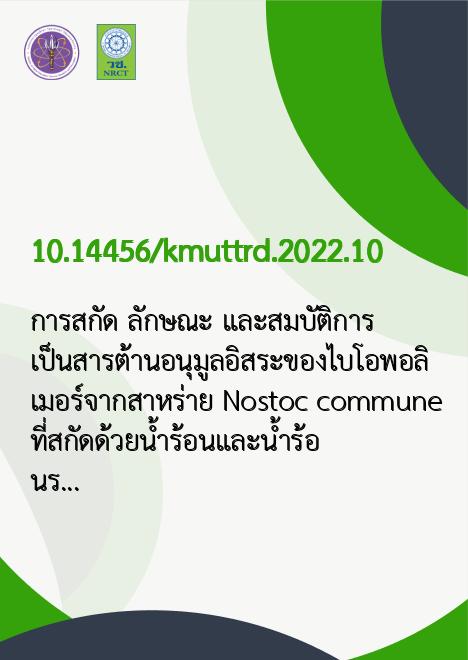
|
การสกัด ลักษณะ และสมบัติการเป็นสารต้านอนุมูลอิสระของไบโอพอลิเมอร์จากสาหร่าย Nostoc commune ที่สกัดด้วยน้ำร้อนและน้ำร้อนร่วมกับคลื่นเสียงความถี่สูง |
|---|---|
| รหัสดีโอไอ | |
| Creator | ณัฎฐา เลาหกุลจิตต์ |
| Title | การสกัด ลักษณะ และสมบัติการเป็นสารต้านอนุมูลอิสระของไบโอพอลิเมอร์จากสาหร่าย Nostoc commune ที่สกัดด้วยน้ำร้อนและน้ำร้อนร่วมกับคลื่นเสียงความถี่สูง |
| Contributor | บุณยกร บุญยะธาน อภิรดี อุทัยรัตนกิจ ณัติฐพล ไข่แสงศรี |
| Publisher | King Mongkut’s University of Technology Thonburi |
| Publication Year | 2565 |
| Journal Title | KMUTT Research and Development Journal |
| Journal Vol. | 45 |
| Journal No. | 2 |
| Page no. | 171-192 |
| Keyword | Antioxidant Activity, Pseudoplastic Fluids, Biopolymers, Nostoc commune, Extraction Methods |
| URL Website | https://journal.kmutt.ac.th/ |
| Website title | เว็บไซต์วารสารวิจัยและพัฒนา มจธ. |
| ISSN | 2697-5521 |
| Abstract | Nostoc commune Vaucher, commonly known as “HedLarb,” is a species of cyanobacteria (blue-green algae), composing of various bioactive compounds, especially biopolymers (polysaccharides and proteins). The aim of this research was to study the best extraction conditions, in terms of physicochemical properties, molecular weight and rheological behavior, of biopolymers from N. commune; hot water extraction and combined hot-water and ultrasound-assisted extraction (UAE) were tested. The best condition for hot-water extraction was four times of extraction, at a ratio of solid to liquid of 1:60 (w/v) and temperature of 90 °C for 3 h. On the other hand, the best condition for combined hot-water and ultrasound-assisted extraction was four times of extraction, at a ratio of solid to liquid of 1:60 g/mL, ultrasonic power of 400 W at 80 °C for 30 min. The biopolymers from the best conditions of both hot water and combined hot-water and ultrasound-assisted extraction exhibited Mw of 4.49x106 and 2.32x106 Da, respectively. The extracted biopolymers via hot-water extraction and combined hot-water and ultrasound-assisted extraction showed ABTS+ antioxidant capacity of 92.03% and 95.35%, and DPPH antioxidant capacity of 39.13% and 42%, respectively. Rheological behaviors of the extracted biopolymers were pseudo-plastic, with weak gel property at a concentration of 0.8 % (w/v). |